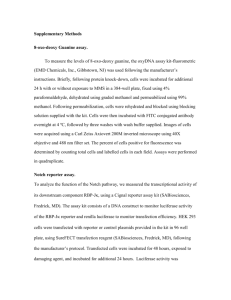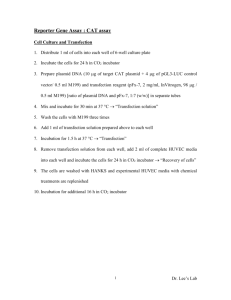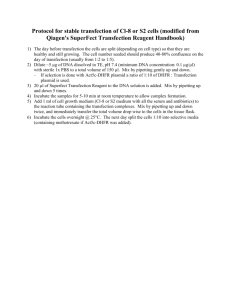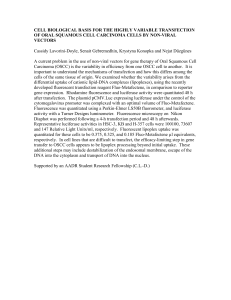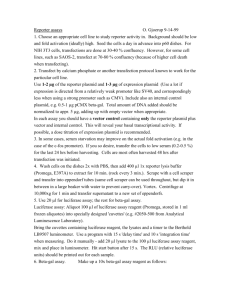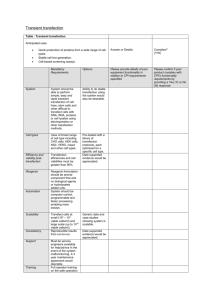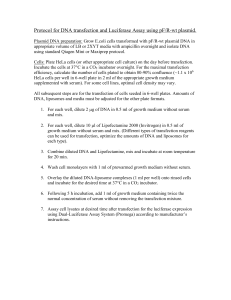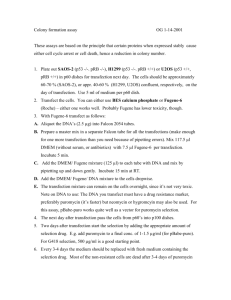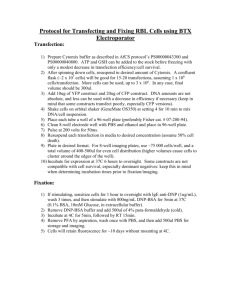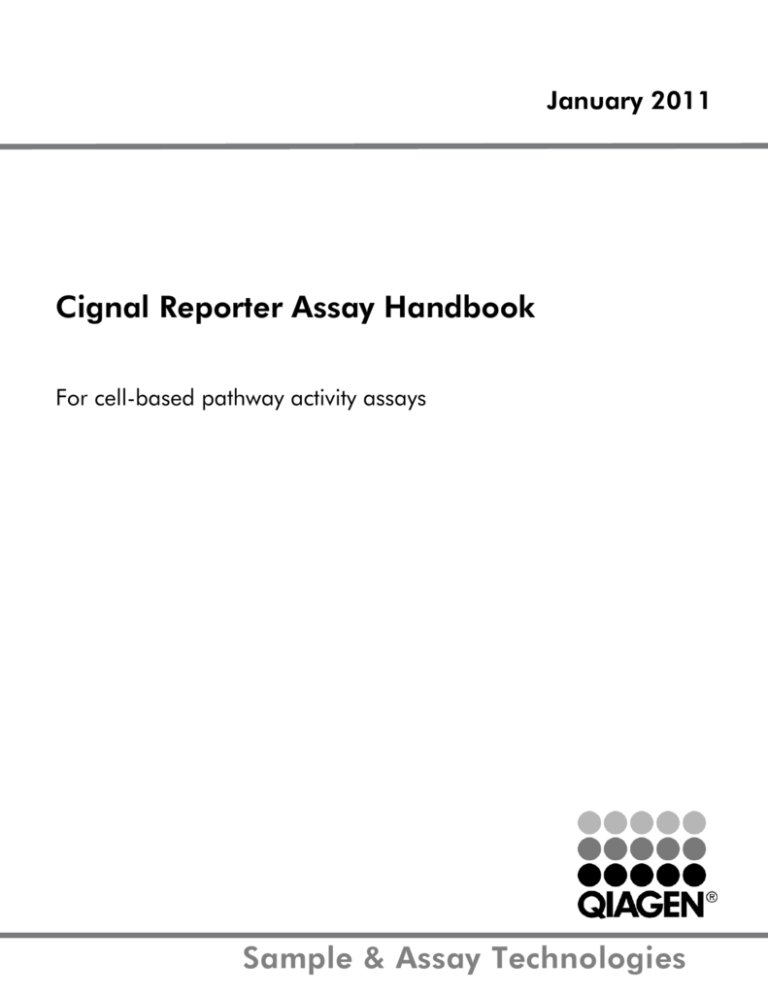
January 2011
Cignal Reporter Assay Handbook
For cell-based pathway activity assays
Sample & Assay Technologies
QIAGEN Sample and Assay Technologies
QIAGEN is the leading provider of innovative sample and assay technologies,
enabling the isolation and detection of contents of any biological sample. Our
advanced, high-quality products and services ensure success from sample to result.
QIAGEN sets standards in:
Purification of DNA, RNA, and proteins
Nucleic acid and protein assays
microRNA research and RNAi
Automation of sample and assay technologies
Our mission is to enable you to achieve outstanding success and breakthroughs.
For more information, visit www.qiagen.com.
Product Use Limitations
Cignal Reporter Assay Kits are intended for molecular biology applications. These
products are not intended for the diagnosis, prevention, or treatment of a disease.
CONTENTS
I.
Introduction
4
II.
Product Contents and Descriptions
8
III.
Additional Materials Required
12
IV.
Protocol
13
A.
Before you begin
13
B.
Generalized Transfection Protocols
14
C.
Co-transfection Protocol for siRNA + Reporter Assay
16
D.
Co-transfection Protocol for shRNA + Reporter Assay
19
E.
Co-transfection Protocol for Expression Vector
+ Reporter Assay
22
F.
Transfection and Treatment Protocol for Reporter
Assay + Small Molecules/Organic Compounds
25
G.
Transfection and Treatment Protocol for Reporter
Assay + Peptide/Recombinant Protein
28
H.
Scaling up Transfection Experiments
31
Appendix: Cignal Reporter Assay Kits and Controls
32
Ordering information
34
I. Introduction
The Cignal Reporter Assays are designed for accurate, sensitive and quantitative
assessment of the activation of signal transduction pathways. SABiosciences has
developed a series of inducible reporter constructs that encode a reporter gene under
the control of a basal promoter element (TATA box) joined to tandem repeats of specific
transcriptional response elements (TRE; Figures 1A and 1B). Transcription factor
activities can act as readouts for the intracellular status of many signal transduction
pathways. Our constructs are specifically engineered for measuring changes in activity
(both increases and decreases) of these signaling pathways. Each of the Cignal
reporter assays is available in a dual-luciferase format. In addition, six of the Cignal
reporter assays are also available as GFP reporter constructs. These include the CRE,
SRE, AP-1, NFkB, SMAD, and TCF/LEF Cignal Reporter Assays. The Cignal reporter
assays are valuable tools for deciphering gene function, as well as determining the
mechanism of action of proteins, peptides, ligands, and small molecule compounds.
Each of the dual-luciferase formatted reporters encodes for the mammalian codonoptimized, non-secreted form of the firefly luciferase gene, carrying a proteindestabilizing sequence. Cells rapidly degrade the destabilized form of the firefly
luciferase protein and hence the background luciferase activity (noise level) is greatly
reduced. Due to low background activity, the magnitude of the response that can be
measured (signal to noise ratio) as well as the speed of measuring changes in
transcription are enhanced. The Cignal dual-luciferase reporter assays provide
outstanding reproducibility, sensitivity, specificity, and signal to noise ratio. They are
extremely useful for carrying out endpoint pathway regulation assays.
The Cignal GFP reporter assays enable you to monitor the dynamics of pathway
activation on living cells with single cell resolution. The Cignal GFP reporter constructs
utilize the Monster Green™ Fluorescent Protein reporter gene. Monster GFP is
encoded by an improved synthetic version of the green fluorescent protein gene. This
GFP expression cassette has been codon optimized to maximize mammalian cell
expression and also utilizes an optimized Kozak sequence to increase translation
efficiency. The synthetic GFP is an ideal fluorescent reporter, providing high-level
fluorescence and minimal cytotoxicity. Moreover, the synthetic GFP gene is resistant to
photobleaching. In addition, most consensus sequences for transcription factor binding
have been removed from the synthetic GFP gene in order to minimize aberrant
transcription and improve the reliability of the GFP as an accurate reporter. The spectral
properties of the synthetic GFP are slightly red-shifted compared to other commercially
available GFPs. Peak excitation occurs at 505nm, with a shoulder at 480nm; peak
emission occurs at 515nm.
4
Benefits of Cignal Reporter Assays
•
PERFORMANCE: Both the dual-luciferase and GFP reporter systems provide
exceptional sensitivity, reproducibility, specificity, and signal to noise ratio
•
VERSATILITY: Can monitor signal transduction pathway activity utilizing the
dual-luciferase reporter system in an endpoint format assay, or measure pathway
activation dynamics on live cells using the GFP reporter system
•
CONVENIENCE: Transfection-ready constructs, including positive and negative
controls, coupled with a transient reporter system, enable rapid analysis of signal
transduction pathway regulation.
5
Figure 1A: Overview of Cignal Dual-Luciferase Reporter Assays Process.
6
Figure 1B:
Overview of Cignal GFP Reporter Assays Process.
7
II.
Product
Descriptions
A.
Contents
and
Dual-Luciferase Reporter Assay Kits:
1. Kit Contents
Table 1: Cignal Reporter Assay Kit Specifications
Component
Reporter
Negative
control
Positive
control
Concentration
and
total volume
Specification
A mixture of an inducible transcription factor
responsive firefly luciferase reporter and (100 ng/μl; 500 µl)
constitutively expressing Renilla construct
(40:1).
A mixture of non-inducible firefly luciferase
reporter and constitutively expressing (100 ng/μl; 500 µl)
Renilla construct (40:1).
A mixture of a constitutively expressing GFP
construct, constitutively expressing firefly (100 ng/μl; 250 µl)
luciferase construct, and constitutively
expressing Renilla luciferase construct
(40:1:1).
NOTE: These constructs are transfection-grade and are ready for transient
transfection. These constructs are specifically designed to inhibit transformation and are
NOT MEANT for introduction and amplification in bacteria.
2. Description:
Each Cignal Reporter Assay Kit includes the following components:
1. Reporter: The reporter is a mixture of inducible transcription factor responsive
construct and constitutively expressing Renilla luciferase construct (40:1). The
inducible transcription factor-responsive construct encodes the firefly luciferase
reporter gene under the control of a basal promoter element (TATA box) joined to
tandem repeats of a specific Transcriptional Response Element (TRE; Figure 2A).
This construct monitors both increases and decreases in the activity of a key
transcription factor, which is a downstream target of a specific signaling pathway.
The constitutively expressing Renilla construct encodes the Renilla luciferase
reporter gene under the control of a CMV immediate early enhancer/promoter
8
(Figure 2B) and acts as an internal control for normalizing transfection efficiencies
and monitoring cell viability. It is also useful to confirm transfection and to verify
active luciferase in the transfected culture.
2. Negative control: The negative control is a mixture of non-inducible reporter
construct and constitutively expressing Renilla luciferase construct (40:1). The noninducible reporter construct encodes firefly luciferase under the control of a basal
promoter element (TATA box), without any additional transcriptional response
elements (Figure 2C). The negative control is critical to identifying specific effects
and determining background reporter activity.
3. Positive control: The positive control is a constitutively expressing GFP construct
(Figure 2D), pre-mixed with a constitutively expressing firefly luciferase construct
(Figure 2E), and a constitutively expressing Renilla luciferase construct (Figure 2B)
(40:1:1). The positive control is necessary for visual confirmation of transfection. It is
also useful for transfection optimization studies. The expression of the GFP from the
positive control construct can be monitored by fluorescence microscopy using an
excitation filter of 470 ± 20 nm (470 / 40 nm) and an emission filter of 515 nm (long
pass).
A.
B.
Tandem repeats
of TREs
TATA box
Firefly Luc
CMV immediate early
enhancer/promoter
Renilla Luc
TATA box
C.
Firefly Luc
D.
CMV immediate early
enhancer/promoter
MGFP
E.
CMV immediate early
enhancer/promoter
Firefly Luc
9
Figure
2:
Schematic
representation
of
constructs
involved in the Cignal Reporter Assay. (A) The inducible
transcription factor-responsive construct expressing firefly luciferase, (B) The
constitutively expressing Renilla luciferase construct, (C) The non-inducible firefly
luciferase reporter construct, (D) The constitutively expressing GFP construct, and (E)
The constitutively expressing firefly luciferase construct.
B. GFP Reporter Assay Kits:
1. Kit Contents
Table 2: Cignal GFP Reporter Assay Kit Specifications
Component
Reporter
Specification
Concentration
and
total volume
An inducible transcription factor responsive
GFP reporter
(100 ng/μl; 500 µl)
Negative
control
A GFP reporter construct in which GFP
expression is controlled by a minimal (100 ng/μl; 500 µl)
promoter
Positive
A constitutively expressing GFP construct
control
(100 ng/μl; 250 µl)
NOTE: These constructs are transfection-grade and are ready for transient
transfection. These constructs are specifically designed to inhibit transformation and are
NOT MEANT for introduction and amplification in bacteria.
2. Description:
Each Cignal GFP Reporter Assay Kit includes the following components:
1. Reporter: The inducible transcription factor-responsive GFP reporter encodes the
green fluorescent protein gene under the control of a basal promoter element (TATA
box) joined to tandem repeats of a specific Transcriptional Response Element (TRE;
Figure 3A). This construct monitors both increases and decreases in the activity of a
key transcription factor, which is a downstream target of a specific signaling pathway
2. Negative control: The negative control is a GFP reporter that encodes the green
fluorescent protein under the control of a basal promoter element (TATA box),
without any additional transcriptional response elements (Figure 3B). The negative
10
control is critical to identifying pathway-specific effects and determining background
reporter activity.
3. Positive control: The positive control is a constitutively expressing GFP construct
(Figure 3C). The positive control is necessary for visual confirmation of transfection.
It is also useful for transfection optimization studies.
A.
Tandem repeats
of TREs
TATA box
GFP
TATA box
B.
C.
GFP
CMV immediate early
enhancer/promoter
GFP
Figure 3: Schematic representation of constructs involved in Cignal GFP Reporter
Assay. (A) The inducible transcription factor-responsive reporter expressing GFP, (B)
The GFP reporter controlled by a minimal promoter (negative control), (C) The
constitutively expressing GFP construct (positive control).
IMPORTANT NOTE: There are a few reports in the literature of the CMV regulatory element
being activated by certain stimuli (see below). We recommend that you confirm that the stimulus
used in each Cignal reporter assay does not induce the CMV regulatory element, in order to
confirm that the CMV-Renilla construct is the appropriate normalization construct for your
experiment. This can be done empirically by testing the impact of your stimulus on the Cignal
positive control reporters, which are each under the control of the CMV enhancer/promoter
cassette. If your stimulus is one of the very few reported activators of the CMV regulatory
element, we advise using an alternative reporter as an internal control.
•
W. Bruening, B. Giasson, W. Mushynski, and H. D. Durham. 1998. Nucleic Acids
Research 26(2):486-489. Activation of stress-activated MAP protein kinases
up-regulates expression of transgenes driven by the cytomegalovirus
immediate/early promoter
11
•
Madhu S. Malo, Moushumi Mozumder, Alexander Chen, Golam Mostafa,
Xiao Bo Zhang, Richard A. Hodin. 2006. Analytical Biochemistry 350:307309. pFRL7: An ideal vector for eukaryotic promoter analysis
III. Additional Materials
Required:
Mammalian cell line cultured in the appropriate growth medium
Cell culture medium and standard cell culture supplies
96-well tissue culture plates
Multi-channel pipettor and pipettor reservoirs
Transfection reagent [We recommend Attractene Transfection Reagent
(QIAGEN, cat. no. 301005), however, other transfection reagents work equally
well]
Polystyrene test tubes (BD FALCON, Cat # 352099)
Opti-MEM® I Reduced Serum Medium (Invitrogen, Cat. No. 31985-062)
Fetal bovine serum (FBS)
Non-essential amino acids (NEAA) (Invitrogen, Cat. No. 11140-050)
Penicillin/Streptomycin
Hemacytometer
Dual-Luciferase® Assay System
o Dual-Luciferase® Reporter Assay System (Promega, Cat. No. E1910)
This system requires cell lysis, and is well-suited for the rapid quantitation of both
luciferase reporters when using luminometers with reagent auto-injectors.
o Dual-Glo® Luciferase Assay System (Promega, Cat. No. E2920)
This system is used to assay for both luciferase reporters on intact cells in growth
medium. This system can be used with any luminometer, including those without
reagent auto-injectors.
96-well white opaque flat bottom microtiter plate
12
Luminometer
FACS, flow cytometer, fluorescent microscope, or fluorometer
IV. Protocol:
A. Before you begin:
1. Cell line selection: The Cignal Reporter Assay may be used with various
mammalian cell lines. Cell lines show a great deal of variation in the levels of
signaling proteins. The transcriptional activator activities in the cell line used will
determine the sensitivity of the assay. A cell line should be selected based on the
functionality of the signal transduction pathway under investigation, as well as for
the “transfectability” of the cell line (see below).
2. Transfection reagent selection: We recommend the use of Attractene Transfection
Reagent (cat. no. 301005) as a transfection reagent. The Cignal Reporter Assay,
however, also performs equally well with other transfection reagents such as
Lipofectamine 2000 (Invitrogen, Cat. No. 11668-027), or FuGENE 6 (Roche, Cat.
No. 1815091). When using alternative transfection reagents, please refer to the
manufacturer’s instructions on the use of those reagents.
3. Optimization of transfection conditions: The sensitivity of the Cignal Reporter Assay
depends on the transfection efficiency. The transfection efficiency, in turn, primarily
depends upon cell line used. Therefore, it is very important to optimize the
transfection conditions for each cell type under study. Variables to consider, when
optimizing the transfection conditions include cell density, cell viability, amount of
DNA, ratio of DNA to transfection reagent, transfection complex formation time, and
transfection incubation time (see the detailed protocols for our recommendations).
The positive control construct included with each Cignal Reporter Assay can be
used for determining the optimal transfection conditions.
4. Optimization of assay condition: The response rate in the Cignal Reporter Assay
depends on the assay conditions (conditions of the experimental treatment). To
obtain maximum response given by any stimulus, perform dosing and time-course
studies. The optimal amount of stimulus and the time of treatment must be obtained
empirically for each experiment (see different protocols for our recommendations).
5. Important recommendations for best results:
A. Perform all transfections in triplicate to minimize variability among treatment
groups.
B. Include positive and negative controls in each experiment to obtain reliable
results.
13
C. Use low-passage cells that are actively growing and are greater than 90%
viable, for maximal transfection efficiencies.
D. Do not add antibiotics to media during transfection, as this may cause cell
death.
E. Take care to always seed the same number of cells in each well, in order to
maximize the reproducibility of your experiment.
F. Serum induces various signaling pathways, leading to cross-talk and high
background. Therefore, use reduced amounts of serum (0.5%) in the assay
medium during the experimental treatment to minimize these serum effects.
B. Generalized Transfection Protocols:
We recommend using reverse transfection protocols with the Attractene Transfection
Reagent throughout the Cignal Reporter Assays User Manual. This is due to the time
savings and improved reproducibility of using this method, compared to traditional
forward transfection methods. However, Cignal Reporter Assays also work well with
traditional forward transfection methods and transfection reagents from other vendors.
Below are general protocol overviews for the Cignal Reporter Assays, using either
reverse or forward transfection approaches.
1. Reverse Transfection Protocol Overview (1 DAY PROCEDURE)
DAY 1
Prepare nucleic acid mixtures in appropriate ratios. This may include any of
the following combinations, depending upon the experimental design (we
recommend carrying out each transfection condition in triplicate):
Experimental transfection
i. Cignal Reporter + test nucleic acid (expression plasmids, shRNA
plasmids, or siRNAs)
14
Control transfections
ii. Cignal Reporter + negative control for test nucleic acid
iii. Cignal Negative Control + test nucleic acid (expression plasmids,
shRNA plasmids, or siRNAs)
iv. Cignal Negative Control + negative control for test nucleic acid
v. Cignal Positive Control
Dilute Attractene into Opti-MEM
Add diluted Attractene to nucleic acid mixtures, incubate at room
temperature for 20 minutes
Trypsinize (if necessary), count, and suspend cells to appropriate density
Aliquot transfection complexes into wells
Immediately seed cells to each well *
* For detailed information on the transfection conditions, and treatment of
cultures post-transfection, refer to the application-specific protocols within this
user manual.
2. Traditional Transfection Protocol Overview (2 DAY PROCEDURE)
DAY 1
Trypsinize (if necessary), count, and suspend cells to appropriate density
Seed cells into multiwell plate(s)
DAY 2
Prepare nucleic acid mixtures in appropriate ratios. This may include any of
the following combinations, depending upon the experimental design (we
recommend carrying out each transfection condition in triplicate):
15
Experimental transfection
i. Cignal Reporter + test nucleic acid (expression plasmids, shRNA
plasmids, or siRNAs)
Control transfections
ii. Cignal Reporter + negative control for test nucleic acid
iii. Cignal Negative Control + test nucleic acid (expression plasmids,
shRNA plasmids, or siRNAs)
iv. Cignal Negative Control + negative control for test nucleic acid
v. Cignal Positive Control
Dilute Attractene Transfection Reagent into appropriate medium (If you are
using a transfection reagent other than Attractene Transfection
Reagent follow their manufacturer’s protocol for transfection)
Add diluted transfection reagent to nucleic acid mixtures, incubate at room
temperature for 20 minutes
Aliquot transfection complexes into wells containing overnight cell cultures
C. Co-transfection Protocol for siRNA + Reporter
Assay
The following protocol is designed to reverse transfect adherent cell line, HEK-293H,
using Attractene Transfection Reagent (cat. no. 301005) in a 96-well plate format. The
Cignal Reporter Assay works well with transfection reagents from other vendors. If you
are using a transfection reagent other than Attractene Transfection Reagent follow their
manufacturer’s protocol for optimizing transfection. The Cignal Reporter Assay also
works well using traditional forward transfection protocols. Moreover, if you are using
plates or wells of different size, adjust the components in proportion to the surface area
(see section IV.H). This is just a general guideline; the optimal conditions/amounts
should be optimized according to the cell type and the study requirements. Read
the protocol completely before starting the experiment.
IMPORTANT: (1) Do not add antibiotics to media during transfection as this
causes cell death.
16
Table 2: Guidelines for setting up co-transfections of
siRNA and Cignal Reporter Assays. Table 2 represents the total
components needed, on a per well basis, for each condition to be tested. Note that
individual components must be added sequentially, as instructed in the protocol.
#
1
2
3
4
5
Cignal
Reporter
(per well)
Cignal
Negative
Control
(per well)
Cignal
Positive
Control
(per well)
100 ng
(1.0 μl)
100 ng
(1.0 μl)
Specific
siRNA
(per well)
Negative
Control
siRNA
(per well)
Opti-MEM
Nucleic
Acid
Diluent
(per well)
Attractene
(per well)
Opti-MEM
Attractene
Diluent
(per well)
2 pmol
25 μl
0.6 μl
25 μl
25 μl
0.6 μl
25 μl
25 μl
0.6 μl
25 μl
25 μl
0.6 μl
25 μl
25 μl
0.6 μl
25 μl
2 pmol
100 ng
(1.0 μl)
100 ng
(1.0 μl)
2 pmol
2 pmol
100 ng
(1.0 μl)
Time of
transfection
(hours)
48 h or 72 h
1. The recommended experimental setup, on a per well basis, follows. Please note
that we recommend setting up multiple replicates for each condition, and preparing
transfection cocktail volumes sufficient for transfecting multiple wells. In addition, we
advise always taking 5-10% extra amounts of nucleic acid, Opti-MEM® serum-free
culture medium, and Attractene to compensate for pipettor error when setting up
transfection cocktails (steps 1 through 4).
Add 25 µl of Opti-MEM® to each of 5 polystyrene tubes, along with the following:
Experimental transfection
1 μl (100 ng) Cignal reporter + 2 pmol sequence-specific siRNA
Control transfections
1 μl (100 ng) Cignal reporter + 2 pmol negative control siRNA
1 µl (100 ng) Cignal negative control + 2 pmol sequence-specific siRNA
1 µl (100 ng) Cignal negative control + 2 pmol negative control siRNA
1 µl (100 ng) Cignal positive control
Mix each transfection cocktail gently.
2. Prepare an Attractene dilution for 5 tubes (mentioned in step 1) by dispensing 3 µl of
Attractene into 125 µl of Opti-MEM® serum-free culture medium (for every well dilute
0.6 μl of Attractene in 25 µl of Opti-MEM® serum-free culture medium) in a polystyrene
test tube. Mix gently and set the tube at room temperature for 5 minutes.
3. After the 5 minute incubation, add 25 µl of diluted Attractene into each of the five
tubes containing 25 µl of the diluted nucleic acids (1:1 ratio) as detailed in Table 2.
4. Mix gently and incubate for 20 minutes at room temperature to allow complex
formation to occur.
5. Meanwhile, wash cells* in a culture dish once with Dulbecco’s PBS without calcium
and magnesium, and treat with 1-3 ml trypsin-EDTA for 2-5 minutes at 37ºC in a
17
humidified atmosphere containing 5% CO2. Suspend the cells in 7-9 ml of Opti-MEM®
containing 5% of fetal bovine serum, then centrifuge the cells down, remove the
supernatant, and resuspend the cells to 4 x 105 cells/ml in Opti-MEM® containing 5% of
fetal bovine serum and 1% NEAA**. To ensure reproducible transfection results, it is
important to accurately measure the cell density with a hemacytometer or an automated
cytometry device.
6. After the 20 minute incubation for complex formation is completed, aliquot 50 µl of
specific constructs-siRNA-Attractene complexes into the appropriate wells.
7. Add 100 µl of prepared cell suspension (4 x 105 cells/ml in Opti-MEM® containing 5%
of fetal bovine serum) to each well containing constructs-siRNA-Attractene complexes.
This gives a final volume of 150 µl. Mix gently by rocking the plate back and forth.
8. Incubate cells at 37°C in a 5% CO2 incubator for 16-24 hours.
9. After 16-24 hours of transfection, change the medium to complete growth medium
(DMEM with 10% FBS, 0.1mM NEAA, 1mM Sodium pyruvate, 100 U/ml penicillin and
100 µg/ml streptomycin).
10. To study the effect of knockdown, we recommend harvesting cells 48 or 72 hours
after transfection to perform dual-luciferase assay.
12. The luciferase assay can be developed by using Dual-Luciferase Reporter Assay
System from Promega (Cat. No. 1910). Follow the manufacturer’s protocol for
developing the assay.
Expression of the Monster GFP reporter can be monitored via FACS, flow cytometry,
fluorescent microscopy, or standard fluorometry. The spectral properties of the Monster
Green Fluorescent Protein are slightly red-shifted compared to other commercially
available GFP reporters. We recommend using the standard FACS settings of an argon
laser (488 nm excitation) and filters of 530+15 nm (530/30 nm) for emission. When
analyzing GFP expression via fluorescent microscopy or standard fluorometry, we
recommend using standard fluoroisothiocyanate (FITC) filters [excitation of 470+20 nm
and an emission filter of 515 nm (long pass)].
*Cells that have been passed 1:3 or 1:4 the day before are generally more easily
transfected than cells that have reached a confluent state at the time of use.
** In most cases, cells grow well in Opti-MEM® serum-reduced growth medium with 35% FBS due to extra growth factors and nutrients supplied in Opti-MEM®. Cell should
reach ~50-90% confluence once attached to the wells, otherwise increase the cell
numbers.
18
D. Co-transfection Protocol for shRNA + Reporter
Assay
The following protocol is designed to reverse transfect adherent cell line, HEK-293H,
using Attractene Transfection Reagent (cat. no. 301005) in a 96-well plate format. The
Cignal Reporter Assay works well with transfection reagent from other vendors. If you
are using transfection reagent other than Attractene Transfection Reagent follow their
manufacturer’s protocol for transfection. The Cignal Reporter Assay also works well
using traditional forward transfection protocols. Moreover, if you are using plates or
wells of different size, adjust the components in proportion to the surface area (see
section IV.H). This is just a general guideline; the optimal conditions/amounts
should be adjusted according to the cell type and study requirements. Read the
protocol completely before starting the experiment.
IMPORTANT: (1) Do not add antibiotics to media during transfection as this
causes cell death.
Table 3: Guidelines for setting up co-transfections of
a shRNA vector and Cignal Reporter Assay. Table 3 represents
the total components needed, on a per well basis, for each condition to be tested. Note
that individual components must be added sequentially, as instructed in the protocol.
#
1
2
3
4
5
Cignal
Reporter
(per well)
Cignal
Negative
Control
(per well)
Cignal
Positive
Control
(per well)
100 ng
(1.0 μl)
100 ng
(1.0 μl)
Specific
shRNA
(per well)
Negative
Control
shRNA
(per well)
Opti-MEM
Nucleic
Acid
Diluent
(per well)
Attractene
(per well)
Opti-MEM
Attractene
Diluent
(per well)
200 ng
25 μl
0.6 μl
25 μl
25 μl
0.6 μl
25 μl
25 μl
0.6 μl
25 μl
25 μl
0.6 μl
25 μl
25 μl
0.6 μl
25 μl
200 ng
100 ng
(1.0 μl)
100 ng
(1.0 μl)
200 ng
200 ng
100 ng
(1.0 μl)
Time of
transfection
(hours)
48 h or 72 h
1. The recommended experimental setup, on a per well basis, follows. Please note
that we recommend setting up multiple replicates for each condition, and preparing
transfection cocktail volumes sufficient for transfecting multiple wells. In addition, we
advise always taking 5-10% extra amounts of nucleic acid, Opti-MEM® serum-free
culture medium, and Attractene to compensate for pipettor error when setting up
transfection cocktails (steps 1 through 4).
Add 25 µl of Opti-MEM® to each of 5 polystyrene tubes, along with the following:
Experimental transfection
1 µl (100 ng) Cignal reporter + 200 ng sequence-specific shRNA
Control transfections
1 µl (100 ng) Cignal reporter + 200 ng negative control shRNA
19
1 µl (100 ng) Cignal negative control + 200 ng sequence-specific shRNA
1 µl (100 ng) Cignal negative control + 200 ng negative control shRNA
1 µl (100 ng) Cignal positive control
Mix each transfection cocktail gently.
2. Prepare an Attractene dilution for 5 tubes (mentioned in step 1) by dispensing 3 µl of
Attractene into 125 µl of Opti-MEM® serum-free culture medium (for every well dilute
0.6 μl of Attractene in 25 µl of Opti-MEM® serum-free culture medium) in a polystyrene
test tube. Mix gently and set the tube at room temperature for 5 minutes.
3. After the 5 minute incubation, add 25 µl of diluted Attractene into each of the five
tubes containing 25 µl of diluted constructs (1:1 ratio) as detailed in Table 3.
4. Mix gently and incubate for 20 minutes at room temperature to allow complex
formation to occur.
5. Meanwhile, wash cells* in a culture dish once with Dulbecco’s PBS without calcium
and magnesium, and treat with 1-3 ml trypsin-EDTA for 2-5 minutes at 37ºC in a
humidified atmosphere containing 5% CO2. Suspend the cells in 7-9 ml of Opti-MEM®
containing 5% of fetal bovine serum, then centrifuge the cells down, remove the
supernatant, and resuspend the cells to 4 ×105 cells/ml in Opti-MEM® containing 5% of
fetal bovine serum and 1% NEAA**. To ensure reproducible transfection results, it is
important to accurately measure the cell density with a hemacytometer or automated
cytometry device.
6. After the 20 minute incubation for complex formation is completed, aliquot 50 µl of
specific constructs-shRNA-Attractene complexes into the appropriate wells.
7. Add 100 µl of prepared cell suspension (4 ×105 cells/ml in Opti-MEM® containing 5%
of fetal bovine serum) to each well containing construct-shRNA-Attractene complexes.
This gives a final volume of 150 µl. Mix gently by rocking the plate back and forth.
8. Incubate cells at 37°C in a 5% CO2 incubator for 16-24 hours.
9. After 16-24 hours of transfection, change the medium to complete growth medium
(DMEM with 10% FBS, 0.1mM NEAA, 1mM Sodium pyruvate, 100 U/ml penicillin and
100 µg/ml streptomycin).
10. To study the effect of knockdown, we recommend harvesting cells 48 or 72 hours
after transfection to perform dual-luciferase assay.
11. The luciferase assay can be developed by using Dual-Luciferase Reporter Assay
System from Promega (Cat. No. 1910). Follow the manufacturer’s protocol for
developing the assay.
Expression of the Monster GFP® reporter can be monitored via FACS, flow cytometry,
fluorescent microscopy, or standard fluorometry. The spectral properties of the Monster
Green Fluorescent Protein are slightly red-shifted compared to other commercially
20
available GFP reporters. We recommend using the standard FACS settings of an argon
laser (488 nm excitation) and filters of 530+15 nm (530/30 nm) for emission. When
analyzing GFP expression via fluorescent microscopy or standard fluorometry, we
recommend using standard fluoroisothiocyanate (FITC) filters [excitation of 470+20 nm
and an emission filter of 515 nm (long pass)].
*Cells that have been passed 1:3 or 1:4 the day before are generally more easily
transfected than cells that have reached a confluent state at the time of use.
**In most cases, cells grow well in Opti-MEM® serum reduced growth medium with 3%5% FBS due to extra growth factors and nutrients supplied in Opti-MEM®. Cell should
reach ~50-90% confluence once attached to the wells, otherwise increase the cell
numbers.
21
E. Co-transfection Protocol for Expression Vector +
Reporter Assay
The following protocol is designed to reverse transfect adherent cell line, HEK-293H,
using Attractene Transfection Reagent (cat. no. 301005) in a 96-well plate format. The
Cignal Reporter Assay works well with transfection reagent from other vendors. If you
are using transfection reagent other than Attractene Transfection Reagent follow their
manufacturer’s protocol for transfection. The Cignal Reporter Assay also works well
using traditional forward transfection protocols. Moreover, if you are using plates or wells
of different size, adjust the component in proportion to the surface area (see section
IV.H). This is just a general guideline; the optimal conditions/amounts should be
adjusted according to the cell type and the study requirements. Read the protocol
completely before starting the experiment.
IMPORTANT: (1) Do not add antibiotics to media during transfection as this
causes cell death.
Table 4: Guidelines for setting up co-transfections of
an expression vector and Cignal Reporter Assay. Table 4
2
3
4
5
6
7
8
9
a
Opti-MEM
Nucleic Acid
Diluent
(per well)
Attractene
(per well)
Opti-MEM
Attractene
Diluent
(per well)
100 ng
100
ng
25 μl
0.6 μl
25 μl
200 ng
100
ng
100 ng
200 ng
100 ng
(1.0 μl)
100 ng
(1.0 μl)
100 ng
(1.0 μl)
100 ng
(1.0 μl)
100 ng
100
ng
200 ng
100
ng
100 ng
200 ng
100 ng
(1.0 μl)
25 μl
0.6 μl
25 μl
25 μl
0.6 μl
25 μl
25 μl
0.6 μl
25 μl
25 μl
0.6 μl
25 μl
25 μl
0.6 μl
25 μl
25 μl
0.6 μl
25 μl
25 μl
0.6 μl
25 μl
25 μl
0.6 μl
25 μl
Time of
transfection
(hours)
Carrier
a
DNA
Experimental
Vector with
Gene of
Interest
(per well)
Cignal
Negative
Control
(per well)
Cignal
Positive
Control
(per well)
100 ng
(1.0 μl)
100 ng
(1.0 μl)
100 ng
(1.0 μl)
100 ng
(1.0 μl)
Experimental
Vector
Without
Insert
(per well)
1
Cignal
Reporter
(per well)
#
represents the total components needed, on a per well basis, for each condition to be
tested. Note that individual components must be added sequentially, as instructed in
the protocol.
32 h - 48 h
Carrier DNA means any empty plasmid, such as a pUC or a pBR plasmid.
1. The recommended experimental setup, on a per well basis, follows. Please note
that we recommend setting up multiple replicates for each condition, and preparing
transfection cocktail volumes sufficient for transfecting multiple wells. In addition, we
advise always taking 5-10% extra amounts of nucleic acid, Opti-MEM® serum-free
22
culture medium, and Attractene to compensate for pipettor error when setting up
transfection cocktails (steps 1 through 4).
Add 25 µl of Opti-MEM® to each of 9 polystyrene tubes, along with the following:
Experimental transfections
1 μl (100 ng) Cignal reporter + 100 ng experimental vector expressing gene of
interest + 100 ng carrier DNA
1 μl (100 ng) Cignal reporter + 200 ng experimental vector expressing gene of
interest
Control transfections
1 μl (100 ng) Cignal reporter + 100 ng negative control expression vector
+ 100 ng carrier DNA
1 μl (100 ng) Cignal reporter + 200 ng negative control expression vector
1 µl (100 ng) Cignal negative control + 100 ng experimental vector expressing
gene of interest + 100 ng carrier DNA
1 µl (100 ng) Cignal negative control + 200 ng experimental vector expressing
gene of interest
1 µl (100 ng) Cignal negative control + 100 ng negative control expression
vector + 100 ng carrier DNA
1 µl (100 ng) Cignal negative control + 200 ng negative control expression
vector
1 µl (100 ng) Cignal positive control
Mix each transfection cocktail gently.
2. Prepare an Attractene dilution for 9 tubes (mentioned in step 1) by dispensing 5.4 µl
of Attractene into 225 µl of Opti-MEM® serum-free culture medium (for every well dilute
0.6 μl of Attractene in 25 µl of Opti-MEM® serum-free culture medium) in a polystyrene
test tube. Mix gently and set the tube at room temperature for 5 minutes.
3. After the 5 minute incubation, add 25 µl of diluted Attractene into each of the nine
tubes containing 25 µl of diluted constructs (1:1 ratio) as detailed in Table 4.
4. Mix gently and incubate for 20 minutes at room temperature to allow complex
formation to occur.
5. Meanwhile, wash cells* in a culture dish once with Dulbecco’s PBS without calcium
and magnesium, and treat with 1-3 ml trypsin-EDTA for 2-5 minutes at 37ºC in a
humidified atmosphere containing 5% CO2. Suspend the cells in 7-9 ml of Opti-MEM®
containing 5% of fetal bovine serum, then centrifuge the cells down, remove the
supernatant, and resuspend the cells to 4 ×105 cells/ml in Opti-MEM® containing 5% of
fetal bovine serum and 1% NEAA**. To ensure reproducible transfection results, it is
important to accurately measure the cell density with a hemacytometer or automated
cytometry device.
23
6. After the 20 minute incubation for complex formation is completed, aliquot 50 µl of
specific complexes into the appropriate wells.
7. Add 100 µl of prepared cell suspension (4 ×105 cells/ml in Opti-MEM® containing 5%
of fetal bovine serum) to each well containing construct-vector-Attractene complexes.
This gives a final volume of 150 µl. Mix gently by rocking the plate back and forth.
8. Incubate cells at 37°C in a 5% CO2 incubator for 16-24 hours.
9. After 16-24 hours of transfection, change the medium to complete growth medium
(DMEM with 10% FBS, 0.1mM NEAA, 1mM Sodium pyruvate, 100 U/ml penicillin and
100 µg/ml streptomycin).
11. To study the effect of the gene product, we recommend harvesting cells 32 hours or
48 hours after transfection to perform the dual-luciferase assay.
12. The luciferase assay can be developed by using Dual-Luciferase Reporter Assay
System from Promega (Cat. No. 1910). Follow the manufacturer’s protocol for
developing the assay.
Expression of the Monster GFP reporter can be monitored via FACS, flow cytometry,
fluorescent microscopy, or standard fluorometry. The spectral properties of the Monster
Green Fluorescent Protein are slightly red-shifted compared to other commercially
available GFP reporters. We recommend using the standard FACS settings of an argon
laser (488 nm excitation) and filters of 530+15 nm (530/30nm) for emission. When
analyzing GFP expression via fluorescent microscopy or standard fluorometry, we
recommend using standard fluoroisothiocyanate (FITC) filters [excitation of 470+20 nm
and an emission filter of 515nm (long pass)].
*Cells that have been passed 1:3 or 1:4 the day before are generally more easily
transfected than cells that have reached a confluent state at the time of use.
**In most cases, cells grow well in Opti-MEM® serum reduced growth medium with 3%5% FBS due to extra growth factors and nutrients supplied in Opti-MEM®. Cell should
reach ~50-90% confluence once attached to the wells, otherwise increase the cell
numbers.
24
F. Transfection and Treatment Protocol for Reporter
Assay + Small Molecules/Organic Compounds
The following protocol is designed to reverse transfect adherent cell line, HEK-293H,
using Attractene Transfection Reagent (cat. no. 301005) as a transfection reagent in 96well plate format. The Cignal reporter assay works well with transfection reagent from
other vendors. If you are using transfection reagent other than Attractene follow their
manufacturer’s protocol for transfection. The Cignal Reporter Assay also works well
using traditional forward transfection protocols. Moreover, if you are using plates or wells
of different size, adjust the component in proportion to the surface area (see section
IV.H). This is just a general guideline; the optimal conditions/amounts should be
adjusted according to the cell type and the study requirements. Read the protocol
completely before starting the experiment.
IMPORTANT: (1) Do not add antibiotics to media during transfection as this
causes cell death.
Table 5: Guidelines for studying the effect of small
molecules/organic compounds. Table 5 represents the total components
needed, on a per well basis, for each condition to be tested. Note that individual
components must be added sequentially, as instructed in the protocol.
#
1
2
3
4
5
6
7
8
9
a
Cignal
Reporter
(per well)
Cignal
Negative
Control
(per well)
Cignal
Positive
Control
Construct
(per well)
100 ng
(1.0 μl)
100 ng
(1.0 μl)
100 ng
(1.0 μl)
100 ng
(1.0 μl)
Small
Molecule/
Organic
Compound
(per well)
Opti-MEM
DNA
diluent
(per well)
Attractene
(per well)
Opti-MEM
Attractene
diluent
(per well)
25 μl
0.6 μl
25 μl
a
25 μl
0.6 μl
25 μl
10X
25 μl
0.6 μl
25 μl
100X
25 μl
0.6 μl
25 μl
25 μl
0.6 μl
25 μl
1X
25 μl
0.6 μl
25 μl
10X
25 μl
0.6 μl
25 μl
100X
25 μl
0.6 μl
25 μl
25 μl
0.6 μl
25 μl
1X
100 ng
(1.0 μl)
100 ng
(1.0 μl)
100 ng
(1.0 μl)
100 ng
(1.0 μl)
100 ng
(1.0 μl)
Time of
Transfection
(hours)
30 h or 42 h
1X is a smallest appropriate amount of small molecule or organic compound expected to modulate
signaling pathway.
1. The recommended experimental setup, on a per well basis, follows. Please note
that we recommend setting up multiple replicates for each condition, and preparing
transfection cocktail volumes sufficient for transfecting multiple wells. In addition, we
advise always taking 5-10% extra amounts of nucleic acid, Opti-MEM® serum-free
25
culture medium, and Attractene to compensate for pipettor error when setting up
transfection cocktails (steps 1 through 4).
Set up three polystyrene tubes, as follows
Experimental transfections
Tubes 1 - 4:
100 µl Opti-MEM® + 4 μl (400 ng) Cignal reporter (4 volumes for
conditions 1 to 4 of Table 5; for every well dilute 1 μl (100 ng) of
Cignal reporter in 25 µl of Opti-MEM® serum-free culture medium)
Control transfections
Tubes 5 - 8:
100 µl Opti-MEM® + 4 μl (400 ng) Cignal negative control (4
volumes for conditions 5 to 8 of Table 5; for every well dilute 1 μl
(100 ng) of Cignal reporter in 25 µl of Opti-MEM® serum-free
culture medium)
Tube 9:
25 µl Opti-MEM® + 1μl (100 ng) Cignal positive control
Mix each transfection cocktail gently.
2. Prepare an Attractene dilution for 9 tubes (mentioned in step 1) by dispensing 5.4 µl
of Attractene into 225 µl of Opti-MEM® serum-free culture medium (for every well dilute
0.6 μl of Attractene in 25 µl of Opti-MEM® serum-free culture medium) in a polystyrene
test tube. Mix gently and set the tube at room temperature for 5 minutes.
3. After the 5 minute incubation, add 100 µl of diluted Attractene to the two tubes
(mentioned in step 1) containing equal volume (100 µl) of diluted Cignal reporter, and
add 25 µl of diluted Attractene into the positive control tube containing 25 µl of diluted
constructs (1:1 ratio) as detailed in Table 5.
4. Mix gently and incubate for 20 minutes at room temperature to allow complex
formation to occur.
5. Meanwhile, wash cells* in culture dish once with Dulbecco’s PBS without calcium
and magnesium, and treat with 1-3 ml trypsin-EDTA for 2-5 minutes at 37 ºC in a
humidified atmosphere containing 5% CO2. Suspend the cells in 7-9 ml of Opti-MEM®
containing 5% of fetal bovine serum, then centrifuge the cells down, remove the
supernatant, and resuspend the cells to 4 ×105 cells/ml in Opti-MEM® containing 5% of
fetal bovine serum and 1% NEAA**. To ensure reproducible transfection results, it is
important to accurately determine the cell density with a hemacytometer or an
automated cytometry device.
6. After the 20 minute incubation for complex formation is completed, aliquot 50 µl of
specific complexes into the appropriate wells.
7. Add 100 µl of prepared cell suspension (4 ×105 cells/ml in Opti-MEM® containing 5%
of fetal bovine serum) to each well containing constructs- Attractene complexes. This
gives a final volume of 150 µl. Mix gently by rocking the plate back and forth.
26
8. Incubate cells at 37°C in a 5% CO2 incubator for 16 hours.
9. After 16 hours of transfection, change medium to assay medium (Opti-MEM®
containing 0.5% of fetal bovine serum, 1% NEAA, 100 U/ml Penicillin and 100 µg/ml
Streptomycin).
10. After 24 hours of transfection, treat the cells, as described in Table 5, with 1×, 10×
and 100× amount of small molecule or organic compound (1× is the lowest appropriate
amount of small molecule or organic compound expected to modulate the signaling
pathway).
11. To study the effect of small molecule or organic compound, we recommend
harvesting cells 6 hours or 18 hours after treatment to perform dual-luciferase assay.
12. The luciferase assay can be developed by using Dual-Luciferase Reporter Assay
System from Promega (Cat. No. 1910). Follow the manufacturer’s protocol for
developing the assay.
Expression of the Monster GFP reporter can be monitored via FACS, flow cytometry,
fluorescent microscopy, or standard fluorometry. The spectral properties of the Monster
Green Fluorescent Protein are slightly red-shifted compared to other commercially
available GFP reporters. We recommend using the standard FACS settings of an argon
laser (488 nm excitation) and filters of 530+15 nm (530/30 nm) for emission. When
analyzing GFP expression via fluorescent microscopy or standard fluorometry, we
recommend using standard fluoroisothiocyanate (FITC) filters [excitation of 470+20 nm
and an emission filter of 515 nm (long pass)].
*Cells that had been passed 1:3 or 1:4 the day before are generally more easily
transfected than cells that have reached a confluent state at the time of use.
**In most cases, cells grow well in Opti-MEM® serum reduced growth medium with 3%5% FBS due to extra growth factors and nutrients supplied in Opti-MEM®. Cell
should reach ~50-90% confluence once attached to the wells, otherwise increase the
cell numbers.
27
G. Transfection and Treatment Protocol for Reporter
Assay + Peptide/Recombinant Protein
The following protocol is designed to reverse transfect adherent cell line, HEK-293H,
using Attractene Transfection Reagent (cat. no. 301005) in a 96-well plate format. The
Cignal reporter assay works well with transfection reagent from other vendors. If you are
using transfection reagent other than Attractene follow their manufacturer’s protocol for
transfection. The Cignal Reporter Assay also works well using traditional forward
transfection protocols. Moreover, if you are using plates or wells of different size, adjust
the component in proportion to the surface area (see section IV.F). This is just a
general guideline; the optimal conditions/amounts should be adjusted according
to the cell type and the study requirements. Read the protocol completely before
starting the experiment.
IMPORTANT: (1) Do not add antibiotics to media during transfection as this
causes cell death.
Table 6: Guidelines for studying the effect of a
peptide or recombinant protein.
Table 6 represents the total components needed, on a per well basis, for each condition
to be tested. Note that individual components must be added sequentially, as instructed
in the protocol.
#
1
2
3
4
5
6
7
8
9
a
Cignal
Reporter
(per well)
Cignal
Negative
Control
(per well)
Cignal
Positive
Control
(per well)
100 ng
(1.0 μl)
100 ng
(1.0 μl)
100 ng
(1.0 μl)
100 ng
(1.0 μl)
Peptide or
Recombinant
Protein
(per well)
Opti-MEM
DNA
Diluent
(per well)
Attractene
(per well)
Opti-MEM
Attractene
diluent
(per well)
25 μl
0.6 μl
25 μl
a
25 μl
0.6 μl
25 μl
10×
25 μl
0.6 μl
25 μl
100×
25 μl
0.6 μl
25 μl
25 μl
0.6 μl
25 μl
1×
25 μl
0.6 μl
25 μl
10×
25 μl
0.6 μl
25 μl
100×
25 μl
0.6 μl
25 μl
25 μl
0.6 μl
25 μl
1×
100 ng
(1.0 μl)
100 ng
(1.0 μl)
100 ng
(1.0 μl)
100 ng
(1.0 μl)
100 ng
(1.0 μl)
Time of
Transfection
(hours)
30 h or 42 h
1X is a smallest appropriate amount of interfering peptide/recombinant protein/growth factor expected to
modulate signaling pathway.
1. The recommended experimental setup, on a per well basis, follows. Please note that
we recommend setting up multiple replicates for each condition, and preparing
transfection cocktail volumes sufficient for transfecting multiple wells. In addition, we
advise always taking 5-10% extra amounts of nucleic acid, Opti-MEM® serum-free
28
culture medium, and Attractene to compensate for pipettor error, when setting up
transfection cocktails (steps 1 through 4).
Set up three polystyrene tubes, as follows:
Experimental transfections
Tubes 1 – 4:
100 µl Opti-MEM® + 4 μl (400 ng) Cignal reporter (4 volumes for
conditions 1 to 4 of Table 6; for every well dilute 1 μl (100 ng) of
Cignal reporter in 25 µl of Opti-MEM® serum-free culture medium)
Control transfections
Tubes 5-8:
100 µl Opti-MEM® + 4 μl (400 ng) Cignal negative control (4
volumes for conditions 5 to 8 of Table 6; for every well dilute 1 μl
(100 ng) of Cignal reporter in 25 µl of Opti-MEM® serum-free
culture medium)
Tube 9:
25 µl Opti-MEM® + 1μl (100 ng) Cignal positive control
Mix each transfection cocktail gently.
2. Prepare an Attractene dilution for 9 tubes (mentioned in step 1) by dispensing 5.4 µl
of Attractene into 225 µl of Opti-MEM® serum-free culture medium (for every well dilute
0.6 μl of Attractene in 25 µl of Opti-MEM® serum-free culture medium) in a polystyrene
test tube. Mix gently and set the tube at room temperature for 5 minutes.
3. After the 5 minute incubation, add 100 µl of diluted Attractene to the two tubes
(mentioned in step 1) containing equal volume (100 µl) of diluted Cignal reporter, and
add 25 µl of diluted Attractene into the positive control tube containing 25 µl of diluted
constructs (1:1 ratio) as detailed in Table 6.
4. Mix gently and incubate for 20 minutes at room temperature to allow complex
formation to occur.
5. Meanwhile, wash cells* in culture dish once with Dulbecco’s PBS without calcium
and magnesium, and treat with 1-3 ml trypsin-EDTA for 2-5 minutes at 37 ºC in a
humidified atmosphere containing 5% CO2. Suspend the cells in 7-9 ml of Opti-MEM®
containing 5% of fetal bovine serum, then centrifuge the cells down, remove the
supernatant, and resuspend the cells to 4 ×105 cells/ml in Opti-MEM® containing 5% of
fetal bovine serum and 1% NEAA**. To ensure reproducible transfection results, it is
important to accurately determine the cell density with a hemacytometer or an
automated cytometry device.
6. After the 20 minute incubation for complex formation is completed, aliquot 50 µl of
specific complexes into the appropriate wells.
29
7. Add 100 µl of prepared cell suspension (4 ×105 cells/ml in Opti-MEM® containing 5%
of fetal bovine serum) to each well containing constructs-Attractene complexes. This
gives a final volume of 150 µl. Mix gently by rocking the plate back and forth.
8. Incubate cells at 37°C in a 5% CO2 incubator for 16 hours.
9. After 16 hours of transfection, change medium to assay medium (Opti-MEM®
containing 0.5% of fetal bovine serum, 1% NEAA, 100 U/ml Penicillin and 100 µg/ml
Streptomycin).
10. After 24 hours of transfection, treat the cells, as described in Table 12, with 1x, 10x
and 100x amount interfering peptide/recombinant protein/growth factor (1x is an
smallest appropriate amount of small molecule or organic compound expected to
modulate signaling pathway).
11. To study the effect of interfering peptide/recombinant protein/growth factor, we
recommend harvesting cells 6 hours or 18 hours after treatment to develop luciferase
assay.
12. The luciferase assay can be developed by using Dual-Luciferase® Reporter Assay
System from Promega (Cat. No. 1910). Follow the manufacturer’s protocol for
developing the assay.
Expression of the Monster GFP reporter can be monitored via FACS, flow cytometry,
fluorescent microscopy, or standard fluorometry. The spectral properties of the Monster
Green Fluorescent Protein are slightly red-shifted compared to other commercially
available GFP reporters. We recommend using the standard FACS settings of an argon
laser (488 nm excitation) and filters of 530+15 nm (530/30nm) for emission. When
analyzing GFP expression via fluorescent microscopy or standard fluorometry, we
recommend using standard fluoroisothiocyanate (FITC) filters [excitation of 470+20 nm
and an emission filter of 515 nm (long pass)].
*Cells that had been passed 1:3 or 1:4 the day before are generally more easily
transfected than cells that have reached a confluent state at the time of use.
** In most cases, cells grow well in Opti-MEM® serum reduced growth medium with 3%5% FBS due to extra growth factors and nutrients supplied in Opti-MEM®. Cell
should reach ~50-90% confluence once attached to the wells, otherwise increase the
cell numbers.
30
H. Scaling up transfection experiments:
To transfect cells in different tissue culture formats, vary the amounts of constructs,
number of cells, and volume of Attractene and medium used in proportion to the surface
area, as shown in the Table 7. The parameters shown in Table 7 are standardized for
HEK-293H cells. Use these parameters as a starting point to optimize transfections
for your cell line of interest.
Table 7. Reagent amounts for
different size culture vessels
Type of
Plate
Surface
Area
2
(cm per
well)
96-well
transfecting
cells
in
siRNA / shRNA
Vector or Gene
Expression
Vector
(per Well)
2 pmol / 200 ng
Starting
Volume of
Attractene
(μl / well)
Starting
Volume of
Attractene
(μl / well)
Volume of
Cell
Suspension
(μl / well)
Starting No.
of Adherent
Cells (per
Well)
Volume of
Opti-MEM
Medium
(μl)
0.3
Starting
amount
of
construct
(ng / well)
100
0.6
0.3
100
40,000
2 X 25
48-well
0.95
150
1.8
0.8
250
130,000
2 X 50
5 pmol / 500 ng
24-well
1.9
250
3.2
1.6
500
250,000
2 X 50
10 pmol / 750 ng
12-well
3.8
500
6.4
3.2
1000
500,000
2 X 100
20 pmol / 1.5 μg
6-well
9.4
1000
16.0
8.0
2500
1500,000
2 X 250
50 pmol / 4.0 μg
35 mm
8.0
1000
16.0
8.0
2500
1500,000
2 X 250
50 pmol / 4.0 μg
5000
3.0 X 10
6
2 X 500
100 pmol / 8.0 μg
9.0 X 10
6
2 X 1500
60 mm
100 mm
21
55
2000
5000
36.0
90.0
18.0
45.0
15000 (15
a
300 pmol / 25 μg
ml)
a
2X means one volume of Opti-MEM® medium for diluting constructs and another
volume of Opti-MEM® medium for diluting Attractene.
For any other troubleshooting or technical questions about the Cignal Reporter
Assay, please call one of our Technical Support representatives at 1-888-503-3187
or 301-682-9200 or email at support@SABiosciences.com.
31
Appendix:
Cignal Reporter Assay Kits
Dual luciferase Cat. No.
MGFP
Cat. No.
Pathway
Transcription Factor
Amino Acid Deprivation
ATF4/ATF3/ATF2
CCS-8034L
Androgen
Androgen Receptor
CCS-1019L
Antioxidant Response
Nrf2 & Nrf1
CCS-5020L
ATF6
ATF6
CCS-9031L
C/EBP
C/EBP
CCS-001L
CCS-1001G
cAMP/PKA
CREB
CCS-002L
CCS-002G
Cell Cycle
E2F/DP1
CCS-003L
DNA Damage
p53
CCS-004L
Early Growth Response
EGR1
CCS-8021L
ER Stress
CBF/NF-Y/YY1
CCS-2032L
Estrogen Receptor
Estrogen Receptor (ER)
CCS-005L
GATA
GATA
CCS-1035L
Glucocorticoid Receptor
Glucocorticoid Receptor (GR)
CCS-006L
Heat Shock Response
HSF
CCS-4023L
Heavy Metal Response
MTF1
CCS-5033L
Hedgehog
Gli
CCS-6030L
Hepatocyte Nuclear Factor 4
HNF4
CCS-3039L
Hypoxia
HIF-1
CCS-007L
Interferon Regulation
IRF-1
CCS-7040L
Interferon Type I
STAT1/STAT2
CCS-008L
Interferon Gamma
STAT1/STAT1
CCS-009L
KLF4
KLF4
CCS-4036L
Liver X Receptor
LXRa
CCS-0041L
32
CCS-3021G
CCS-0033G
CCS-008G
CCS-9036G
MAPK/ERK
Elk-1/SRF
CCS-010L
CCS-010G
MAPK/JNK
AP-1
CCS-011L
CCS-011G
MEF2
MEF2
CCS-7024L
c-Myc
Myc/Max
CCS-012L
Nanog
Nanog
CCS-7037L
NFκB
NFκB
CCS-013L
CCS-013G
Notch
RBP-Jκ
CCS-014L
CCS-1014G
Oct4
Oct4
CCS-0025L
Pax6
Pax6
CCS-3042L
PI3K/AKT
FOXO
CCS-1022L
PKC/Ca++
NFAT
CCS-015L
PPAR
PPAR
CCS-3026L
Progesterone
Progesterone Receptor
CCS-6043L
Retinoic Acid Receptor
RAR
CCS-016L
Retinoid X Receptor
RXR
CCS-9044L
Sox2
Sox2
CCS-0038L
SP1
SP1
CCS-6027L
STAT3
STAT3
CCS-9028
TGFβ
SMAD2/SMAD3/SMAD4
CCS-017L
Vitamin D
VDR
CCS-2029L
Wnt
TCF/LEF
CCS-018L
CCS-018G
Xenobiotic
AhR
CCS-2045L
CCS-7045G
33
CCS-6022G
CCS-1027G
CCS-017G
Cignal Reporter Assay Controls
Control Construct
Cignal Negative Control
(LUC)
Cignal Positive Control
(LUC)
Cignal Negative Control
(GFP)
Cignal Positive Control
(GFP)
Components
Concentration
And Volume
A mixture of non-inducible
firefly luciferase reporter
construct and constitutively
expressing Renilla
luciferase construct (40:1).
A mixture of a constitutively
expressing GFP construct,
constitutively expressing
firefly luciferase construct,
and constitutively
expressing Renilla
luciferase element (40:1:1).
A GFP reporter construct in
which GFP expression is
controlled by a minimal
promoter
A constitutively expressing
GFP construct
Catalog Number
100 ng/µl; 500 µl
CCS-NCL
100 ng/µl; 250 µl
CCS-PCL
100 ng/µl; 500 µl
CCS-NCG
100 ng/µl; 250 µl
CCS-PCG
Ordering Information
Product
Contents
Cat. no.
Cignal Reporter Assay
Kits
Assays in dual-luciferase or GFP format
Varies
For up-to-date licensing information and product-specific disclaimers, see the
respective QIAGEN kit handbook or user manual. QIAGEN kit handbooks and user
manuals are available at www.qiagen.com or can be requested from QIAGEN
Technical Services or your local distributor.
34
Trademarks: QIAGEN® (QIAGEN Group).
Limited License Agreement
Use of this product signifies the agreement of any purchaser or user of the Cignal Reporter Assay Kits to the following terms:
1.
The Cignal Reporter Assay Kits may be used solely in accordance with the Cignal Reporter Assay Handbook and for use with components contained
in the Kit only. QIAGEN grants no license under any of its intellectual property to use or incorporate the enclosed components of this Kit with any
components not included within this Kit except as described in the Cignal Reporter Assay Handbook and additional protocols available at
www.qiagen.com.
2.
Other than expressly stated licenses, QIAGEN makes no warranty that this Kit and/or its use(s) do not infringe the rights of third-parties.
3.
This Kit and its components are licensed for one-time use and may not be reused, refurbished, or resold.
4.
QIAGEN specifically disclaims any other licenses, expressed or implied other than those expressly stated.
5.
The purchaser and user of the Kit agree not to take or permit anyone else to take any steps that could lead to or facilitate any acts prohibited above.
QIAGEN may enforce the prohibitions of this Limited License Agreement in any Court, and shall recover all its investigative and Court costs, including
attorney fees, in any action to enforce this Limited License Agreement or any of its intellectual property rights relating to the Kit and/or its
components.
.
For updated license terms, see www.qiagen.com
Firefly and/or Renilla Luciferase and Monster Green Limited Use Label License
READ THIS FIRST BEFORE OPENING PRODUCT
For research use only. The terms of the limited license conveyed with the purchase of this product are as follows: Researchers may use this product in their
own research and they may transfer derivatives to others for such research use provided that at the time of transfer a copy of this label license is given to
the recipients and the recipients agree to be bound by the conditions of this label license. Researchers shall have no right to modify or otherwise create
variations of the nucleotide sequence of the luciferase gene or Monster Green® gene except that Researchers may: (1) clone heterologous DNA
sequences at either or both ends of said luciferase or Monster Green® gene so as to create fused gene sequences provided that the coding sequence of
the resulting luciferase or Monster Green gene has no more than four deoxynucleotides missing at the affected terminus when compared to the intact
luciferase or Monster Green® gene sequence, and (2) insert and remove nucleic acid sequences in furtherance of splicing research predicated on the
inactivation or reconstitution of the luminescent activity of the encoded luciferase. In addition, Researchers must do one of the following: (1) use
luminescent assay reagents purchased from Promega Corporation for all determinations of luminescence activity resulting from the research use of this
product and its derivatives; or, (2) contact Promega Corporation to obtain a license for the use of the product and its derivatives. No other use or transfer
of this product or its derivatives is authorized without the express written consent of Promega Corporation including, without limitation, Commercial Use.
Commercial Use means any and all uses of this product and derivatives by a party for monetary or other consideration and may include, but is not limited
to use in: (1) product manufacture; and (2) to provide a service, information or data; and/or resale of the product or its derivatives, whether or not such
product or derivatives are resold for use in research. With respect to such Commercial Use, or any diagnostic, therapeutic or prophylactic uses, please
contact Promega Corporation for supply and licensing information. If the purchaser is not willing to accept the conditions of this limited use statement,
SABiosciences is willing to accept the return of the unopened product and provide the purchaser with a full refund. However, in the event the product is
opened, then the purchaser agrees to be bound by the conditions of this limited use statement. The above license relates to Promega Corporation patents
and/or patent applications on improvements to the luciferase and Monster Green® gene.
United States Patent No. 5,292,658 licensed from Millipore Corporation.
Dual-Glo, Dual-Luciferase and Monster Green are trademarks of Promega Corporation.
Opti-MEM is a registered trademark of Life Technologies.
© 2011 QIAGEN, all rights reserved.
www.qiagen.com
Australia Orders 1-800-243-800 Fax 03-9840-9888 Technical 1-800-243-066
Austria Orders 0800-28-10-10 Fax 0800-28-10-19 Technical 0800-28-10-11
Belgium Orders 0800-79612 Fax 0800-79611 Technical 0800-79556
Brazil Orders 0800-557779 Fax 55-11-5079-4001 Technical 0800-557779
Canada Orders 800-572-9613 Fax 800-713-5951 Technical 800-DNA-PREP (800-362-7737)
China Orders 86-21-3865-3865 Fax 86-21-3865-3965 Technical 800-988-0325
Denmark Orders 80-885945 Fax 80-885944 Technical 80-885942
Finland Orders 0800-914416 Fax 0800-914415 Technical 0800-914413
France Orders 01-60-920-926 Fax 01-60-920-925 Technical 01-60-920-930 Offers 01-60-920-928
Germany Orders 02103-29-12000 Fax 02103-29-22000 Technical 02103-29-12400
Hong Kong Orders 800 933 965 Fax 800 930 439 Technical 800 930 425
Ireland Orders 1800 555 049 Fax 1800 555 048 Technical 1800 555 061
Italy Orders 800-789-544 Fax 02-334304-826 Technical 800-787980
Japan Telephone 03-6890-7300 Fax 03-5547-0818 Technical 03-6890-7300
Korea (South) Orders 080-000-7146 Fax 02-2626-5703 Technical 080-000-7145
Luxembourg Orders 8002-2076 Fax 8002-2073 Technical 8002-2067
Mexico Orders 01-800-7742-639 Fax 01-800-1122-330 Technical 01-800-7742-436
The Netherlands Orders 0800-0229592 Fax 0800-0229593 Technical 0800-0229602
Norway Orders 800-18859 Fax 800-18817 Technical 800-18712
Singapore Orders 1800-742-4362 Fax 65-6854-8184 Technical 1800-742-4368
Spain Orders 91-630-7050 Fax 91-630-5145 Technical 91-630-7050
Sweden Orders 020-790282 Fax 020-790582 Technical 020-798328
Switzerland Orders 055-254-22-11 Fax 055-254-22-13 Technical 055-254-22-12
UK Orders 01293-422-911 Fax 01293-422-922 Technical 01293-422-999
USA Orders 800-426-8157 Fax 800-718-2056 Technical 800-DNA-PREP (800-362-7737)
1062766 01/2011
Sample & Assay Technologies

